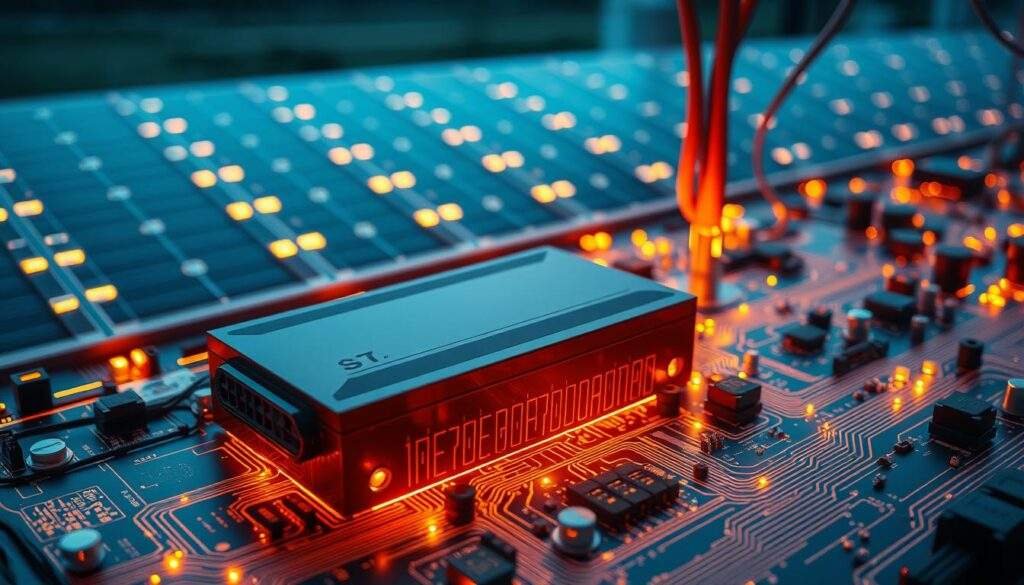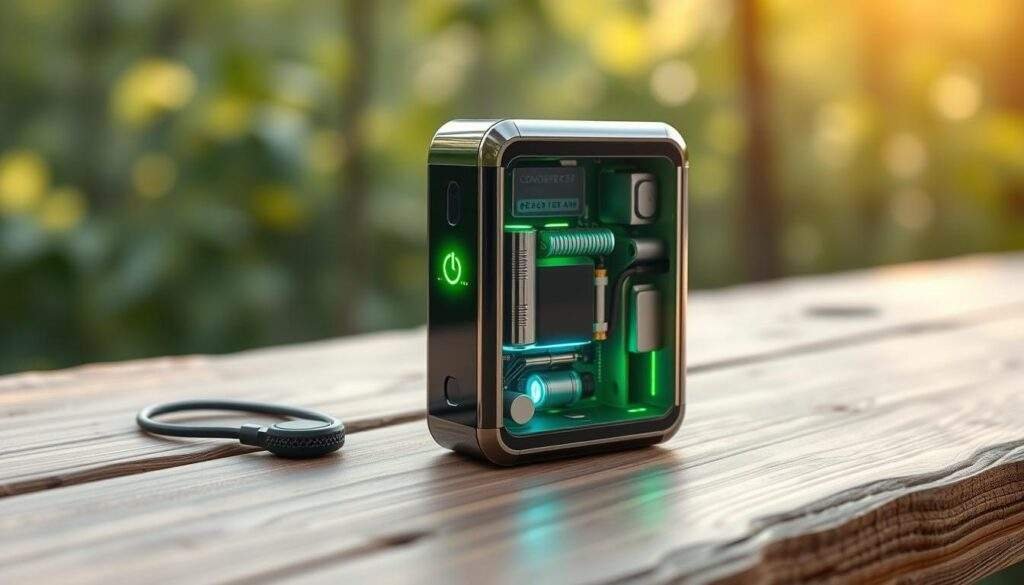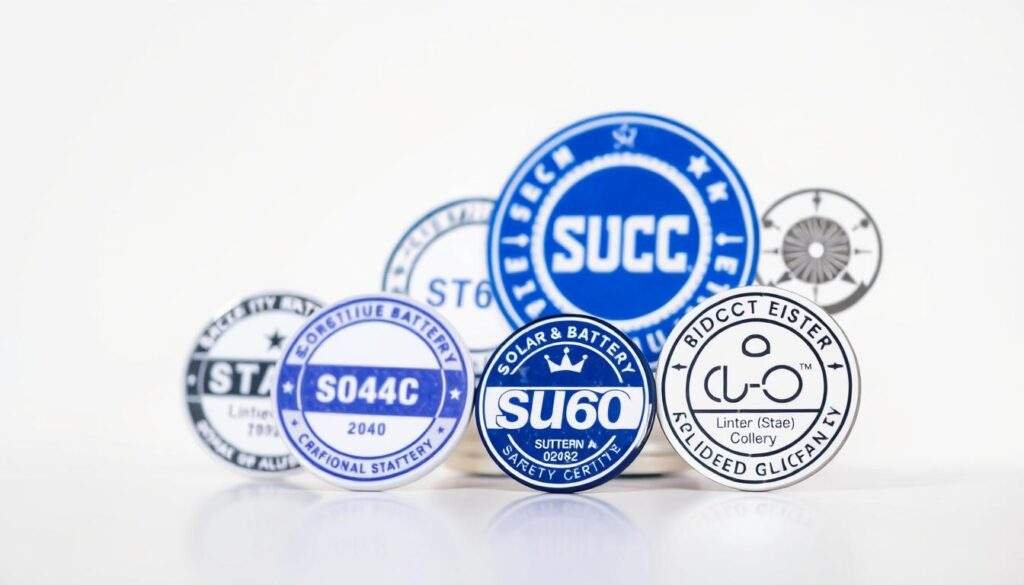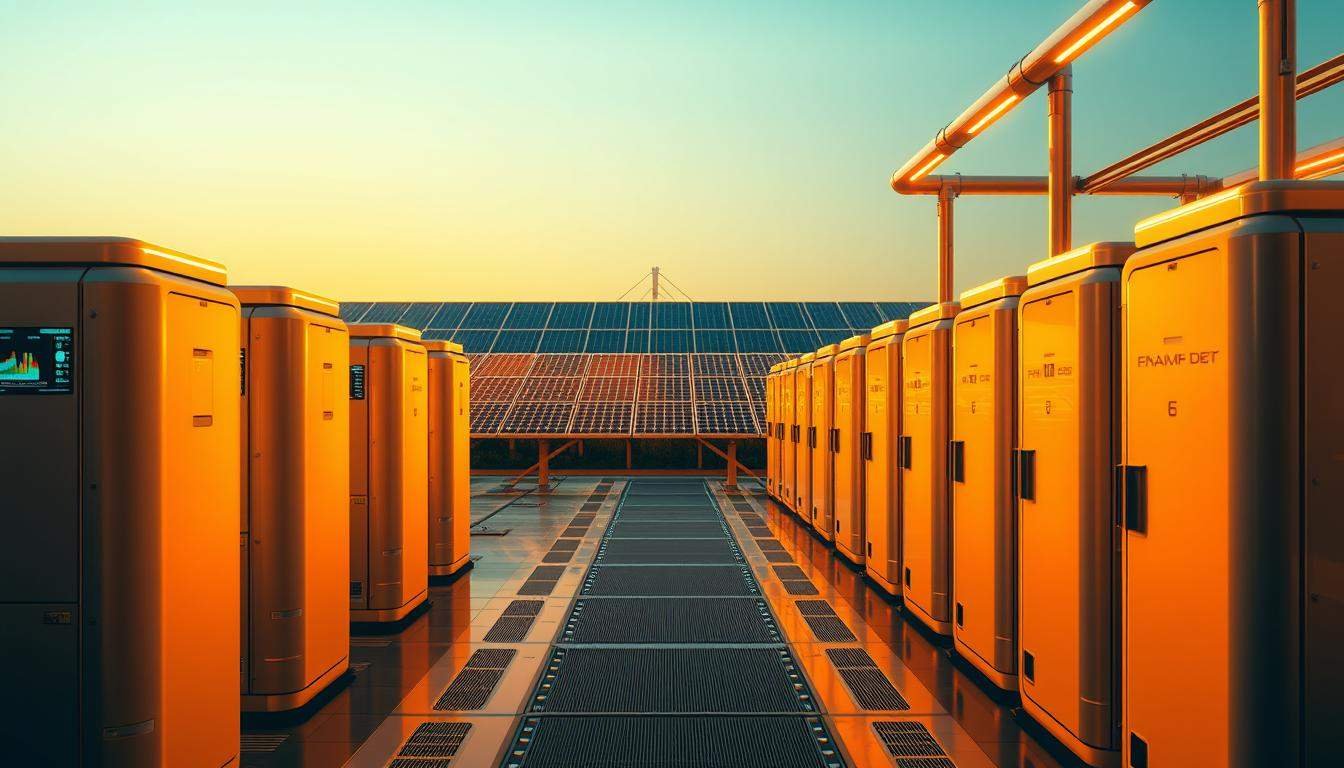Key Safety Features in Modern Solar Battery Technology
When you choose solar energy storage, you want it to be safe and reliable. Did you know the global solar energy market is set to hit 1.3 terawatts by 2025? This growth is thanks to the rising need for renewable energy battery solutions.
So, what makes today’s solar battery tech so safe? It’s the advanced safety features built into these systems. Each battery type has its own safety needs and traits.
If you’re using solar energy at home or work, knowing about these safety features is key. This article will give you a detailed look at the main safety features. They make modern solar battery tech a solid choice for your eco-friendly battery pack needs.
Table of contents
- Understanding Modern Solar Battery Safety
- How to Identify Critical Battery Management Systems (BMS)
- Thermal Management: Keeping Your Solar Battery Safe
- Preventing Overcharge and Deep Discharge
- Solar Battery Types and Their Specific Safety Features
- How to Evaluate Environmental Protection Features
- Fire Safety Systems and How to Verify Them
- Step-by-Step Guide to Verifying Safety Certifications
- Installation Best Practices for Maximum Safety
- Maintenance Routines to Ensure Long-term Safety
- Conclusion: Ensuring Your Solar Battery Investment Remains Safe and Reliable
Understanding Modern Solar Battery Safety
Exploring solar energy means learning about battery safety. Solar batteries are key for storing energy at home. Their safety is vital for your renewable energy system’s reliability.
Why Safety Features Matter in Home Energy Storage
Solar battery safety features protect your home and family. They are critical in home energy storage, where the battery is a big investment. A safe solar battery keeps your system running smoothly, avoiding overheating, fires, or accidents.
The Evolution of Safety in Solar Energy Storage
Solar energy storage has seen big safety improvements. From lead-acid to lithium-ion, safety has driven innovation.
From Lead-Acid to Advanced Lithium Technologies
The move to lithium-ion, like Lithium Iron Phosphate (LFP), has made batteries safer. LFP batteries are stable and less likely to catch fire. They offer:
- Higher thermal stability
- Longer cycle life
- Enhanced safety features
Choosing a solar battery means looking at its safety features. Lithium-ion batteries are a safe, reliable choice for home energy storage.
How to Identify Critical Battery Management Systems (BMS)
To keep your solar battery safe and long-lasting, checking its battery management system (BMS) is key. A good BMS watches over your battery’s health, stops it from getting too hot, and makes sure it works safely.
The Role of BMS in Preventing Catastrophic Failures
A strong BMS is essential for avoiding big problems. It keeps an eye on the battery’s charge, voltage, and temperature all the time. This lets the BMS fix issues before they become big risks.
Key BMS Features to Look For in Your Purchase
When you’re buying a solar battery system, look for a BMS with cool features. You should find cell balancing technology and state of health monitoring. These are important for keeping your battery in top shape.
Cell Balancing Technology
Cell balancing technology makes sure every cell in the battery pack gets charged and discharged right. This stops any cell from getting too full or too empty. It helps your battery work better and last longer.
State of Health Monitoring
State of health monitoring lets you see how your battery is doing over time. It shows you how much life it has left and its overall health. This helps you spot and fix problems early.
Knowing how important a BMS is and what features to look for helps you choose the right solar battery system. This ensures you get the energy storage you need.
Thermal Management: Keeping Your Solar Battery Safe
Thermal management is key to stopping overheating and keeping your solar battery lasting longer. It’s a big part of keeping your solar battery safe. It makes sure your battery stays within a safe temperature range.
How to Recognize Effective Cooling Systems
Finding a good cooling system is important for keeping your battery at the right temperature. Look for these features:
- Heat sinks or heat exchangers that efficiently get rid of heat
- Advanced ventilation systems that help with airflow and cooling
- Thermal interfaces that help transfer heat between parts
Passive vs. Active Thermal Management
There are two main ways to manage heat: passive and active. Passive thermal management uses natural cooling like convection and radiation. Active thermal management uses fans, pumps, or other tools to cool the system. Knowing the difference helps you pick the right one for your solar battery.
Temperature Thresholds and Automatic Shutdowns
Many solar batteries have temperature limits and automatic shutdowns. These features stop the battery from getting too hot. This reduces the chance of damage. Look for a battery with adjustable temperature limits and automatic shutdown to keep it safe.
Preventing Overcharge and Deep Discharge
To keep your lithium-ion solar battery working well, it’s key to avoid overcharge and deep discharge. Using the right charging methods helps keep your battery healthy. This ensures your solar system runs smoothly.
How to Set Up Voltage Limits Correctly
It’s important to set the right voltage limits to stop overcharging. Most lithium-ion batteries have specific voltage ranges to follow. Make sure your charge controller is set to these limits.
Implementing Depth of Discharge Restrictions
Setting DOD limits stops deep discharging, which can damage your battery. It’s best to keep lithium-ion batteries charged above 80% DOD. This helps your battery last longer.
Smart Charging Algorithms and Their Benefits

Smart charging algorithms make charging better, avoiding overcharge and deep discharge.
Solar Battery Types and Their Specific Safety Features
Different solar batteries have their own safety benefits and things to think about. When picking a solar battery for your system, knowing these differences is key. It helps make sure your system is safe and works well.
Lithium Iron Phosphate (LFP) Safety Advantages
Lithium Iron Phosphate (LFP) batteries are safer. They have a stable chemistry that lowers the chance of fires. Plus, they last longer, making them a good pick for storing solar energy.
Lithium NMC Safety Considerations
Lithium NMC batteries are popular for their power but need extra safety steps. They can get too hot and need smart battery management systems (BMS) to stay safe. Make sure your lithium NMC battery has a strong BMS for safe use.
Emerging Technologies with Enhanced Safety Profiles
New solar battery tech is coming, with better safety in mind. Solid-state batteries and new lithium-ion types are being worked on. Staying updated on these new techs can help you choose wisely for your solar needs.
When picking a solar battery, think about its safety features too. Knowing the good and bad of each type helps you pick the right one. This way, you meet your energy needs safely and protect your home and family.
How to Evaluate Environmental Protection Features
Environmental protection features are key to your solar battery system’s reliability. They protect your investment from various environmental factors. This ensures it works efficiently and safely over its lifespan.
Understanding IP Ratings for Weather Resistance
The Ingress Protection (IP) rating is vital for weather resistance. IP ratings have two digits. The first digit shows protection against solid particles, and the second against liquids.
For example, an IP67 rating means the battery is dustproof and can handle being underwater up to 1 meter deep for 30 minutes. When picking a solar battery, choose one with a high IP rating for better weather resistance.

Temperature Tolerance Specifications
Temperature tolerance is another important feature. Solar batteries face many temperatures, and they must perform well in these conditions. Look at the manufacturer’s specs for temperature tolerance.
These specs usually show the operating and storage temperature ranges. A battery that works well across a wide temperature range is more reliable.
Flood and Water Damage Prevention
Preventing flood and water damage is also key, mainly in wet areas. Some solar batteries have special features to keep water out, like sealed casings or waterproof coatings. Knowing these features helps you pick a battery that stays safe and works well in wet conditions.
By carefully checking these environmental protection features, you can make sure your solar battery system is durable and reliable. This gives you a long-term energy solution.
Fire Safety Systems and How to Verify Them
When you choose solar energy, knowing about fire safety is important. Fire safety is a big deal for solar batteries. Today’s designs have many features to lower risks.
Fire Detection and Early Warning Systems
Fire detection and early warning systems are key to avoiding big problems. They watch temperature, voltage, and more to spot issues early. Make sure your solar batteries have these systems to warn you of trouble.
Containment Strategies in Modern Designs
Modern solar batteries have designs to stop fires from spreading. They use special materials and designs to keep fires in one place. When picking solar batteries, check their containment features.
Proper Installation to Minimize Fire Risks
Installing your solar battery system right is essential to avoid fires. Have a skilled installer follow the maker’s rules and local laws. They should focus on good ventilation, secure mounting, and right electrical links.
Some important things to check during installation are:
- Following local building codes and rules
- Enough space around the battery system
- Training for those who will maintain it
Checking these points helps make sure your solar battery system works well and safely.
Step-by-Step Guide to Verifying Safety Certifications
When you buy a solar battery, checking its safety certifications is key. It’s important to make sure your solar battery is safe and reliable. This ensures it works well for you.
Essential UL Standards for Solar Batteries
The Underwriters Laboratories (UL) standards are well-known for solar battery safety. UL 1973 and UL 9540 are important. They check if solar batteries and energy systems are safe and work right.

IEC Compliance Requirements
The International Electrotechnical Commission (IEC) also has safety standards for solar batteries. IEC 62619 and IEC 62133 focus on lithium-ion batteries. These are often used in solar energy systems. If a solar battery meets these standards, it’s been tested for safety.
How to Authenticate Certification Documents
To check if safety certifications are real, look at the documents from the maker. Find the certification number and check it on the UL or IEC site. This confirms your solar battery is safe and meets standards.
By following these steps, you can be sure your solar battery is safe. This means you get a reliable and safe way to store energy.
Installation Best Practices for Maximum Safety
Safety is key when installing solar batteries. There are important steps to take. Installing your solar battery system right ensures it works well and safely.
Choosing the Right Location
Choosing the right spot for your solar battery system is critical. It should be away from sunlight, moisture, and extreme temperatures. Also, make sure it’s well-ventilated to avoid overheating. Think about how easy it is to get to for upkeep.
Proper Ventilation and Clearance Requirements
Proper ventilation is key to avoid gas buildup from batteries. Make sure there’s enough space around the batteries as the maker says. This space helps with cooling and lets techs work safely.
Professional vs. DIY Installation Considerations
While DIY installation might save money, going for professional installation is usually better. Pros know how to set up solar battery systems right and follow safety rules. But, if you’re doing it yourself, know the risks and follow all the rules.
When to Call the Experts
If you’re not sure about anything, call the pros. They can check your situation and tell you the best way to install. They can also fix any problems that come up.
By sticking to these installation best practices, your solar battery system will run safely and efficiently. Always put safety first when working with electrical systems.
Maintenance Routines to Ensure Long-term Safety
To keep your solar battery safe and efficient, follow a maintenance routine. Regular checks help spot problems early, before they get big.
Monthly and Annual Inspection Checklists
Keeping your solar energy storage in good shape means regular inspections. It’s key to check the battery and its parts for wear.
- Look for signs of wear and tear on the battery and its components.
- Make sure all connections are tight and not corroded.
- Check that the system works well within the right temperature range.
Annual checks should be more detailed. They involve a close look at the system’s electrical and mechanical parts.
Software Updates and Why They Matter
Software updates are vital for long-term safety of your solar battery. They fix security issues and boost system performance and efficiency.
Warning Signs That Require Immediate Attention
Watch out for warning signs like odd noises, overheating, or error messages. If you see these, get a pro to check it out right away to avoid bigger problems.
Conclusion: Ensuring Your Solar Battery Investment Remains Safe and Reliable
You now know how to keep your solar battery safe and reliable. Choose a system with a strong Battery Management System (BMS) and good thermal management. This ensures your renewable energy battery works well and safely.
It’s also important to install and maintain your system properly. Following the tips in this article helps protect your investment. This way, you get a steady and safe source of renewable energy.
When you start your solar energy project, check for safety certifications. Regularly inspect your system and keep up with software updates. These actions help keep your solar battery system safe and reliable for your sustainable energy needs.





One Comment